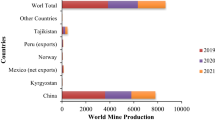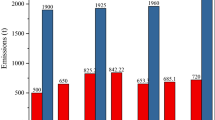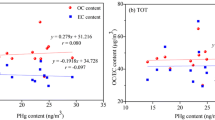Abstract
Mercury, a highly toxic environmental pollutant with a global circulation, must be controlled worldwide. Taking the Wuda underground coal fires, one of the most severe coal fire disaster areas in China, as a typical case, this paper systematically introduces the serious environmental output and strong environmental pollution of mercury from underground coal fires. Smoke with unusually high mercury concentrations was released from surface vents and cracks, resulting in significant enrichment of mercury in the air and surface sediments. A portion of mercury (particulate and reactive gaseous mercury) was deposited near the fire zones, but the positive high mercury fluxes of the surface soils indicated that mercury would again escape from the soil–air interface. The annual gaseous mercury emissions from the underground coal fires in China were estimated to reach 4.85 tonnes. Underground coal-fired mercury can be identified as an essential part of the global mercury cycle. Although some remediation measures were implemented, the development of coal fires proved difficult to control and was destined to be accompanied by the continuous release of mercury. Given the widespread distribution of coal fire cases worldwide, mercury pollution from underground coal fires deserves attention in the future.


Data were compiled from Shan et al. [26]
Similar content being viewed by others
Data availability
The data used in this article are available from the corresponding author upon reasonable request.
References
Stracher GB, Taylor TP (2004) Coal fires burning out of control around the world: thermodynamic recipe for environmental catastrophe. Int J Coal Geol 59(1–2):7–17
Gambhir A, Tavoni M (2019) Direct air carbon capture and sequestration: how it works and how it could contribute to climate-change mitigation. One Earth 1(4):405–409
Elahi E, Khalid Z, Tauni MZ, Zhang H, Lirong X (2022) Extreme weather events risk to crop-production and the adaptation of innovative management strategies to mitigate the risk: a retrospective survey of rural Punjab, Pakistan. Technovation 117:102255
Kuenzer C, Stracher GB (2012) Geomorphology of coal seam fires. Geomorphology 138(1):209–222
Sehn JL, de Leão FB, da Boit K, Oliveira ML, Hidalgo GE, Sampaio CH, Silva LF (2016) Nanomineralogy in the real world: a perspective on nanoparticles in the environmental impacts of coal fire. Chemosphere 147:439–443
Querol X, Izquierdo M, Monfort E, Álvarez E, Font O, Moreno T, Wang Y (2008) Environmental characterization of burnt coal gangue banks at Yangquan, Shanxi Province, China. Int J Coal Geol 75(2):93–104
Kataka MO, Matiane AR, Odhiambo BDO (2018) Chemical and mineralogical characterization of highly and less reactive coal from Northern Natal and Venda-Pafuri coalfields in South Africa. J Afr Earth Sci 137:278–285
Heffern EL, Coates DA (2004) Geologic history of natural coal-bed fires, Powder River basin, USA. Int J Coal Geol 59(1–2):25–47
Zhang X, Kroonenberg SB, De Boer CB (2004) Dating of coal fires in Xinjiang, northwest China. Terra Nova 16(2):68–74
Zeng Q, Dong J, Zhao L (2018) Investigation of the potential risk of coal fire to local environment: a case study of Daquanhu coal fire, Xinjiang region, China. Sci Total Environ 640:1478–1488
Silva LF, Oliveira ML, Neace ER, O’Keefe JM, Henke KR, Hower JC (2011) Nanominerals and ultrafine particles in sublimates from the Ruth Mullins coal fire, Perry County, Eastern Kentucky, USA. Int J Coal Geol 85(2):237–245
Syed TH, Riyas MJ, Kuenzer C (2018) Remote sensing of coal fires in India: a review. Earth Sci Rev 187:338–355
Onifade M, Genc B, Said KO, Fourie M, Akinseye PO (2022) Overview of mine rescue approaches for underground coal fires: a South African perspective. J S Afr Inst Min Metall 122(5):213–226
Tan B, Zhang F, Zhang Q, Wei H, Shao Z (2019) Firefighting of subsurface coal fires with comprehensive techniques for detection and control: a case study of the Fukang coal fire in the Xinjiang region of China. Environ Sci Pollut Res 26(29):29570–29584
Hong X, Liang H, Chen Y, Liu Y, Shi Y (2018) Distribution of fluorine in the surface dust of Wuda coal base, Inner Mongolia of Northern China. J Geochem Explor 188:390–397
Anna M, Andrey F, Eugenia V (2022) Comparison of the performance of different methods to stabilize mercury-containing waste. J Mater Cycles Waste Manag 24(3):1134–1139
Choi Y, Rhee SW (2022) Comprehensive analysis on mercury stream of cold cathode fluorescent lamps (CCFLs) in Korea (Republic of). J Mater Cycles Waste Manag 24(6):2375–2384
Pirrone N, Cinnirella S, Feng X, Finkelman RB, Friedli HR, Leaner J, Telmer K (2010) Global mercury emissions to the atmosphere from anthropogenic and natural sources. Atmos Chem Phys 10(13):5951–5964
Hower JC, Henke K, O’Keefe JM, Engle MA, Blake DR, Stracher GB (2009) The Tiptop coal-mine fire, Kentucky: preliminary investigation of the measurement of mercury and other hazardous gases from coal-fire gas vents. Int J Coal Geol 80(1):63–67
U.S Department of Labor Occupational Safety Health Administration (2004) Safety and health topics: mercury (vapor) (as Hg). http://www.oshs.gov/dts/chemicalsampling/data/CH_250510.html. Accessed 18 Jan 2009
Jaffe D, Prestbo E, Swartzendruber P, Weiss-Penzias P, Kato S, Takami A, Kajii Y (2005) Export of atmospheric mercury from Asia. Atmos Environ 39(17):3029–3038
Li C, Sun J, Shi J, Liang H, Cao Q, Li Z, Gao Y (2020) Mercury sources in a subterranean spontaneous combustion area. Ecotoxicol Environ Saf 201:110863
Kong B, Li Z, Yang Y, Liu Z, Yan D (2017) A review on the mechanism, risk evaluation, and prevention of coal spontaneous combustion in China. Environ Sci Pollut Res 24(30):23453–23470
Zhang J, Guan HY, Cao DY (2008) Underground coal fires in China: origin, detection, fire-fighting, and prevention. China Coal Industry Publishing House, Beijing (in Chinese)
Voigt S, Rüter H (2006) The Sino German coal fire research initiative—research concepts and general aspects of coal seam fire mitigation. In: Buhrow C, Schächter HN, Schmidt R (eds) Kolloquium Ressourcen und Umwelt 2006—Kohle und China, 30–31 März 2006, pp 247–253 (Freiberg, Germany)
Shan B, Wang G, Cao F, Wu D, Liang W, Sun R (2019) Mercury emission from underground coal fires in the mining goaf of the Wuda Coalfield, China. Ecotoxicol Environ Saf 182:109409
Hong X, Yang K, Liang H (2021) Characterization of acidity and sulfate in dust obtained from the Wuda coal base, northern China: spatial distribution and pollution assessment. Environ Sci Pollut Res 28(25):33219–33230
Song Z, Kuenzer C (2017) Spectral reflectance (400–2500 nm) properties of coals, adjacent sediments, metamorphic and pyrometamorphic rocks in coal-fire areas: a case study of Wuda coalfield and its surrounding areas, northern China. Int J Coal Geol 171:142–152
Cao QY, Qian YH, Liang HD, Wang Z (2019) The species and spatial distribution characteristics of atmospheric particulate mercury in Wuda-Wusitai Industrial Park, China. China Environ Sci 39(12):4989–4998
Hong X, Liang H, Lv S, Jia Y, Zhao T, Liang W (2017) Mercury emissions from dynamic monitoring holes of underground coal fires in the Wuda Coalfield, Inner Mongolia, China. Int J Coal Geol 181:78–86
Wang G, Cao F, Shan B, Meng M, Wang W, Sun R (2019) Sources and assessment of mercury and other heavy metal contamination in soils surrounding the Wuda underground coal fire area, Inner Mongolia, China. Bull Environ Contam Toxicol 103(6):828–833
Li C, Liang H, Chen Y, Bai J, Cui Y (2018) Distribution of surface soil mercury of Wuda old mining area, Inner Mongolia, China. Hum Ecol Risk Assess Int J 24(5):1421–1439
Cao QY, Yang L, Ren WY, Song YL, Huang SY, Wang YT, Wang ZY (2021) Spatial distribution of harmful trace elements in Chinese coalfields: an application of WebGIS technology. Sci Total Environ 755:142527
Liang Y, Liang H, Zhu S (2014) Mercury emission from coal seam fire at Wuda Inner Mongolia, China. Atmos Environ 83:176–184
Liang Y, Liang H, Zhu S (2016) Mercury emission from spontaneously ignited coal gangue hill in Wuda coalfield, Inner Mongolia, China. Fuel 182:525–530
Engle MA, Radke LF, Heffern EL, O’Keefe JM, Hower JC, Smeltzer CD, ter Schure A (2012) Gas emissions, minerals, and tars associated with three coal fires, Powder River Basin, USA. Sci Total Environ 420:146–159
O’Keefe JM, Henke KR, Hower JC, Engle MA, Stracher GB, Stucker JD, Lemley EW (2010) CO2 CO, and Hg emissions from the Truman Shepherd and Ruth Mullins coal fires, eastern Kentucky, USA. Sci Total Environ 408(7):1628–1633
Pone JDN, Hein KA, Stracher GB, Annegarn HJ, Finkleman RB, Blake DR, Schroeder P (2007) The spontaneous combustion of coal and its by-products in the Witbank and Sasolburg coalfields of South Africa. Int J Coal Geol 72(2):124–140
Fu X, Feng X, Sommar J, Wang S (2012) A review of studies on atmospheric mercury in China. Sci Total Environ 421:73–81
Wang Z, Chen Z, Duan N, Zhang X (2007) Gaseous elemental mercury concentration in atmosphere at urban and remote sites in China. J Environ Sci 19(2):176–180
Fang F, Wang Q, Li J (2001) Atmospheric particulate mercury concentration and its dry deposition flux in Changchun City, China. Sci Total Environ 281:229–236
Kono Y, Tomiyasu T (2014) Variations in atmospheric mercury concentration in Kagoshima City during 2010–2012. Bunseki Kagaku 63(1):17–21
Huang HC, Lee CL, Lai CH, Fang MD, Lai IC (2012) Transboundary movement of polycyclic aromatic hydrocarbons (PAHs) in the Kuroshio Sphere of the western Pacific Ocean. Atmos Environ 54:470–479
Li C, Liang H, Liang M, Chen Y, Zhou Y (2018) Soil surface Hg emission flux in coalfield in Wuda, Inner Mongolia, China. Environ Sci Pollut Res 25(17):16652–16663
Choi HD, Holsen TM (2009) Gaseous mercury fluxes from the forest floor of the Adirondacks. Environ Pollut 157(2):592–600
Kyllönen K, Hakola H, Hellén H, Korhonen M, Verta M (2012) Atmospheric mercury fluxes in a southern boreal forest and wetland. Water Air Soil Pollut 223(3):1171–1182
Lindberg SE, Zhang H, Gustin M, Vette A, Marsik F, Owens J, Xiao Z (1999) Increases in mercury emissions from desert soils in response to rainfall and irrigation. J Geophys Res Atmos 104(D17):21879–21888
Engle MA, Gustin MS, Zhang H (2001) Quantifying natural source mercury emissions from the Ivanhoe Mining District, north-central Nevada, USA. Atmos Environ 35(23):3987–3997
Gabriel MC, Williamson DG, Zhang H, Brooks S, Lindberg S (2006) Diurnal and seasonal trends in total gaseous mercury flux from three urban ground surfaces. Atmos Environ 40(23):4269–4284
Liu F, Cheng H, Yang K, Zhao C, Liu Y, Peng M, Li K (2014) Characteristics and influencing factors of mercury exchange flux between soil and air in Guangzhou City. J Geochem Explor 139:115–121
Schroeder WH, Beauchamp S, Edwards G, Poissant L, Rasmussen P, Tordon R, Banic CM (2005) Gaseous mercury emissions from natural sources in Canadian landscapes. J Geophys Res Atmos 110:D18302
Ericksen JA, Gustin MS, Xin M, Weisberg PJ, Femandez GCJ (2006) Air–soil exchange of mercury from background soils in the United States. Sci Total Environ 366:851–863
Miller MB, Howard DA, Pierce AM, Cook KR, Keywood M, Powell J, Gustin MS, Edwards GC (2021) Atmospheric reactive mercury concentrations in coastal Australia and the Southern Ocean. Sci Total Environ 751:141681
Fu XW, Feng X, Dong ZQ, Yin RS, Wang JX, Yang ZR, Zhang H (2010) Atmospheric gaseous elemental mercury (GEM) concentrations and mercury depositions at a high-altitude mountain peak in south China. Atmos Chem Phys 10:2425–2437
Sun G, Feng X, Yang C, Zhang L, Yin R, Li Z, Wu Y (2020) Levels, sources, isotope signatures, and health risks of mercury in street dust across China. J Hazard Mater 392:122276
Trasande L, Landrigan PJ, Schechter C (2005) Public health and economic consequences of methyl mercury toxicity to the developing brain. Environ Health Perspect 113(5):590–596
Qian Y, Liang Y, Cao Q, Wang Z, Shi Y, Liang H (2022) Concentration and speciation of mercury in atmospheric particulates in the Wuda coal fire area, Inner Mongolia, China. Environ Sci Pollut Res 29(3):3879–3887
Liu S, Nadim F, Perkins C, Carley RJ, Hoag GE, Lin Y, Chen L (2002) Atmospheric mercury monitoring survey in Beijing, China. Chemosphere 48(1):97–107
Xiu GL, Shi SY, Zhang DN (2003) Preliminary study on characteristics of particulate mercury in fine particles in ambient air. Shanghai Environ Sci 22(5):310–316 (in Chinese)
Ebinghaus R, Kock HH, Temme C, Einax JW, Löwe AG, Richter A et al (2002) Antarctic springtime depletion of atmospheric mercury. Environ Sci Technol 36:1238–1244
Weiss-Penzias P, Amos H, Selin N, Gustin M, Jaffe D, Obrist D et al (2015) Use of a global model to understand speciated atmospheric mercury observations at five high-elevation sites. Atmos Chem Phys 15:1161–1173
Karbassi A, Nasrabadi T, Rezai M et al (2014) Pollution with metals (As, Sb, Hg, Zn) in agricultural soil located close to Zarshuran gold mine, Iran. Environ Eng Manag J 13:155–220
Higueras P, Oyarzun R, Biester H et al (2003) A first insight into mercury distribution and speciation in soils from the Almaden district, Spain. J Geochem Explor 80:95–104
Pataranawat P, Parkpian P, Polprasert C et al (2007) Mercury emission and distribution: potential environmental risks at a small-scale gold mining operation, Phichit Province, Thailand. J Environ Sci Health Part A 42(8):1081–1093
Hower JC, O’Keefe JM, Henke KR, Wagner NJ, Copley G, Blake DR, Silva LF (2013) Gaseous emissions and sublimates from the Truman Shepherd coal fire, Floyd County, Kentucky: a re-investigation following attempted mitigation of the fire. Int J Coal Geol 116:63–74
Querol X, Zhuang X, Font O, Izquierdo M, Alastuey A, Castro I, López-Soler A (2011) Influence of soil cover on reducing the environmental impact of spontaneous coal combustion in coal waste gobs: a review and new experimental data. Int J Coal Geol 85(1):2–22
Li C, Shi J, Cao Q, Luo Y, Liang H, Du C, Shi J (2021) Role of H+, HF, SO42− and kaolin in fixing Hg of coal fire sponge. Sci Total Environ 772:14551
Liang Y, Zhu S, Liang H (2018) Mercury enrichment in coal fire sponge in Wuda coalfield, Inner Mongolia of China. Int J Coal Geol 192:51–55
Rumayor M, Gallego JR, Rodríguez-Valdés E, Díaz-Somoano M (2017) An assessment of the environmental fate of mercury species in highly polluted brownfields by means of thermal desorption. J Hazard Mater 325:1–7
Kuenzer C, Zhang J, Sun Y, Jia Y, Dech S (2012) Coal fires revisited: The Wuda coal field in the aftermath of extensive coal fire research and accelerating extinguishing activities. Int J Coal Geol 102:75–86
Zhou J, Feng X, Liu H, Zhang H, Fu X, Bao Z, Zhang Y (2013) Examination of total mercury inputs by precipitation and litterfall in a remote upland forest of Southwestern China. Atmos Environ 81:364–372
Bergquist BA, Blum JD (2007) Mass-dependent and-independent fractionation of Hg isotopes by photoreduction in aquatic systems. Science 318(5849):417–420
Wu ZJ, Ye HF, Shan YL, Chen B, Li JS (2020) A city-level inventory for atmospheric mercury emissions from coal combustion in China. Atmos Environ 223:117245
United Nations Environment Programme (2019) Global Mercury Assessment 2018
Liang Y, Zhang J, Wang L, Luo H, Ren T (2019) Forecasting spontaneous combustion of coal in underground coal mines by index gases: a review. J Loss Prev Process Ind 57:208–222
Deng J, Ge S, Qi H, Zhou F, Shi B (2021) Underground coal fire emission of spontaneous combustion, Sandaoba coalfield in Xinjiang, China: investigation and analysis. Sci Total Environ 777:146080
Engle MA, Olea RA, O’Keefe JM, Hower JC, Geboy NJ (2013) Direct estimation of diffuse gaseous emissions from coal fires: current methods and future directions. Int J Coal Geol 112:164–172
Tian FC, Liang YT, Zhu HQ, Chen MY, Wang JC (2022) Application of a novel detection approach based on non-dispersive infrared theory to the in-situ analysis on indicator gases from underground coal fire. J Cent South Univ 29:1840–1855
O’Keefe JM, Neace ER, Lemley EW, Hower JC, Henke KR, Copley G, Blake DR (2011) Old Smokey coal fire, Floyd County, Kentucky: estimates of gaseous emission rates. Int J Coal Geol 87(2):150–156
Hou X, Guo L, Wang F, Xu Y, Dong X, Gao D, Sun Y (2019) Research on sources appointment of abnormal co in underground mine. Feb-Fresenius Environ Bull 28(4):2897–2907
Cao QY, Yang L, Qian YH, Liang HD (2020) Study on mercury species in coal and pyrolysis-based mercury removal before utilization. ACS Omega 5(32):20215–20223
Rumayor M, Diaz-Somoano M, Lopez-Anton MA, Martinez-Tarazona MR (2013) Mercury compounds characterization by thermal desorption. Talanta 114:318–322
Acknowledgements
This research is supported by the National Natural Science Foundation of China (41772157 and 41371449) and the State Key Laboratory of Coal Resources and Safe Mining (SKLCRSM17ZZ01).
Author information
Authors and Affiliations
Corresponding author
Ethics declarations
Conflict of interest
The authors declare that they have no conflict of interest.
Additional information
Publisher's Note
Springer Nature remains neutral with regard to jurisdictional claims in published maps and institutional affiliations.
Supplementary Information
Below is the link to the electronic supplementary material.
Rights and permissions
Springer Nature or its licensor (e.g. a society or other partner) holds exclusive rights to this article under a publishing agreement with the author(s) or other rightsholder(s); author self-archiving of the accepted manuscript version of this article is solely governed by the terms of such publishing agreement and applicable law.
About this article
Cite this article
Cao, Q., Cheng, Y., Kusakabe, T. et al. Mercury emission from underground coal fires: a typical case in China. J Mater Cycles Waste Manag 25, 2706–2715 (2023). https://doi.org/10.1007/s10163-023-01616-9
Received:
Accepted:
Published:
Issue Date:
DOI: https://doi.org/10.1007/s10163-023-01616-9






